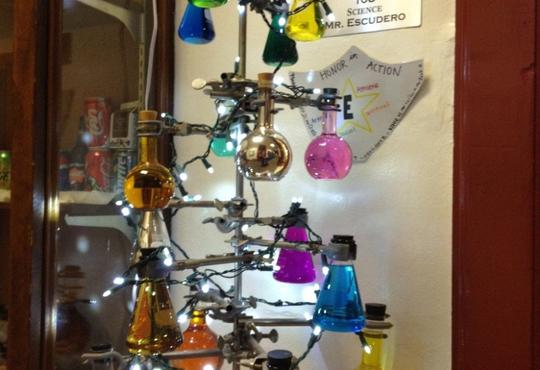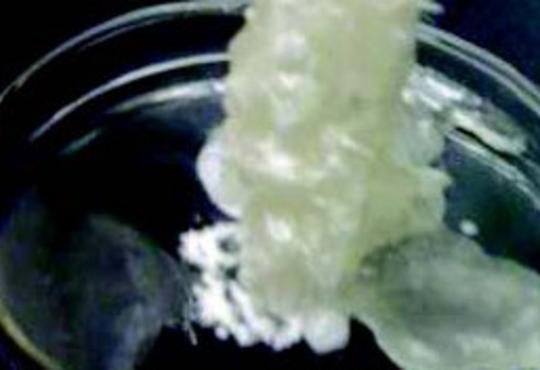Introduction
This article presents the organic chemistry question and solution from the 2012 Canadian Chemistry Contest (CCC) Part C paper. Students competing in the Canadian Chemistry Olympiad (CCO) program are required to write Parts A and C of the CCC each year. Interested teachers are directed towards the CCO website and previous Chem13 News papers1-3 about both the nature of the program and the annual International Chemistry Olympiad (IChO). The CCC Part C problems generally target the areas prescribed by the IChO Steering Committee.4
The problem
The question described here (#3 of Part C) was worth 12 marks out of 60 and focused on some organic chemistry of an antibiotic ((-)-tetracycline) and potential new drug candidates:
- The compound shown below is (-)-tetracycline, which is a potent antibiotic. Circle the chiral centres (stereocentres) in (-)-tetracycline directly on the structure.
- In the provided boxes, state the hybridization of the circled atoms on the structure of (-)-tetracycline below.
Recently, a new antibiotic was synthesized whose structure is shown below (compound 1). It has broad-spectrum activity but suffers from poor bioavailability. Several transformations were carried out to prepare derivatives of the new antibiotic that exhibit the desired properties.
- Using the scheme below, and including stereochemistry where important, draw the structures of compounds A - F.
- What is the absolute configuration of the chiral centre (stereocentre) in compound 1?
- Draw the structure of the two products formed when 1 reacts with molecular bromine, and state the isomeric relationship between them.
The IChO curriculum states4 that the following organic concepts are required knowledge, amongst others: “electrophilic addition: addition to double and triple bonds, regioselectivity (Markovnikoff’s rule), stereochemistry”; “nucleophilic addition: addition to carbon-carbon and carbon-hetero atom double and triple bonds”; “Grignard reactions”; “the Cahn-Ingold-Prelog system” and “hybridization and geometry at carbon centres”. Question #3 focuses on several of these fundamental principles, all of which are taught in a first-year undergraduate course at the University of Toronto (CHM 138H, Introductory Organic Chemistry I).5 Students and their teachers can refer to any introductory organic textbook for more details.6 In part (a), the chiral centres (stereocentres) in (-)-tetracycline have to be identified. These are the carbon atoms singly bonded to four different groups (there are five chiral centres in total that are circled on the molecule below).
Secondly, the hybridization of four atoms (three carbon atoms and one nitrogen atom) is required. Carbon, nitrogen and oxygen atoms that are singly bonded and not involved in electron delocalization via resonance are best described using the sp3-hybridization model. In comparison, these atoms are best described using the sp2-hybridization model when they are part of a double bond, which is composed of a sigma (σ) bond and a pi (π) bond.
The atom causing most problems for students in this part of the question was the amide nitrogen. Many incorrectly identified it as being best described using the sp3-hybridization model. In fact, there is considerable “double-bond character” between the C and N atoms in an amide functional group, leading to restricted rotation.7 This is due to resonance delocalization of the nitrogen electron lone pair by interaction with the carbonyl group.
The reactivity of a bifunctional compound (1, containing an alkene and an ester) is considered in part (c) of Question #3. Basic hydrolysis of the ester forms the carboxylate salt A, which is further subjected to hydrogenation conditions over a palladium catalyst to generate B. Non-Markovnikov addition of water to 1 (hydroboration-oxidation) followed by cyclization leads to lactone C of formula C12H14O2, which is reduced by lithium aluminium hydride to form diol D. The reaction of 1 with excess Grignard reagent synthesizes E (a tertiary alcohol), which undergoes ready dehydration under acidic conditions to form alkene F. These are all transformations taught during an introductory organic course at North American universities.
Part (d) refers to the absolute configuration (R or S) of the chiral centre in compound 1. The Cahn-Ingold-Prelog sequence rules used for specifying the configuration at a chiral centre (or the geometry of an alkene) are outlined in every organic textbook.8 In this instance, the methyl group attached to the chiral centre (indicated by the hashed bond (||||||||) is the group of lowest overall priority, and the three remaining groups are arranged in the following order of increasing priority:
-CH2COOCH3 < -CH=CH2 < -Ph.
Moving from the group of highest priority (-Ph, labelled as “a” in the diagram below) to the groups of lower priority (labelled as “b” and “c” respectively) requires an anti-clockwise rotation, meaning that the absolute configuration is S.
Finally, compound 1 is treated with molecular bromine to form two isomeric products. Br2 will react with the alkene functional group in 1 to form two dibrominated products (a new chiral centre is introduced in both of them). These two compounds are stereoisomers (the same atom connectivity but different three-dimensional arrangement of atoms in space). More specifically, they are diastereomers (non-superimposable non-mirror images) as opposed to enantiomers (non-superimposable mirror images).
Literature cited
- A.P. Dicks, Chem 13 News November 2011, pages 15-16.
- A.P. Dicks, J.C. Janetzko, Chem 13 News January 2012, pages 16-17.
- A.P. Dicks, S. Skonieczny, P. Kim and T. Mirkovic, Chem 13 News October 2012, pages 5-6.
- For a list of IChO regulations and a syllabus, access the 2012 IChO official web site, click on “About IChO” and then “Regulations”.
- CHM 138H course information: https://www.chem.utoronto.ca/undergrad/incoming_students/CHM138H.php
- As an example, see J. McMurry, Organic Chemistry, 8th edition, Thomson Higher Education: Belmont CA, 2012.
- J. McMurry, Organic Chemistry, 8th edition, Thomson Higher Education: Belmont CA, 2012; page 1057.
- J. McMurry, Organic Chemistry, 8th edition, Thomson Higher
Education: Belmont CA, 2012; pages 150-152.







